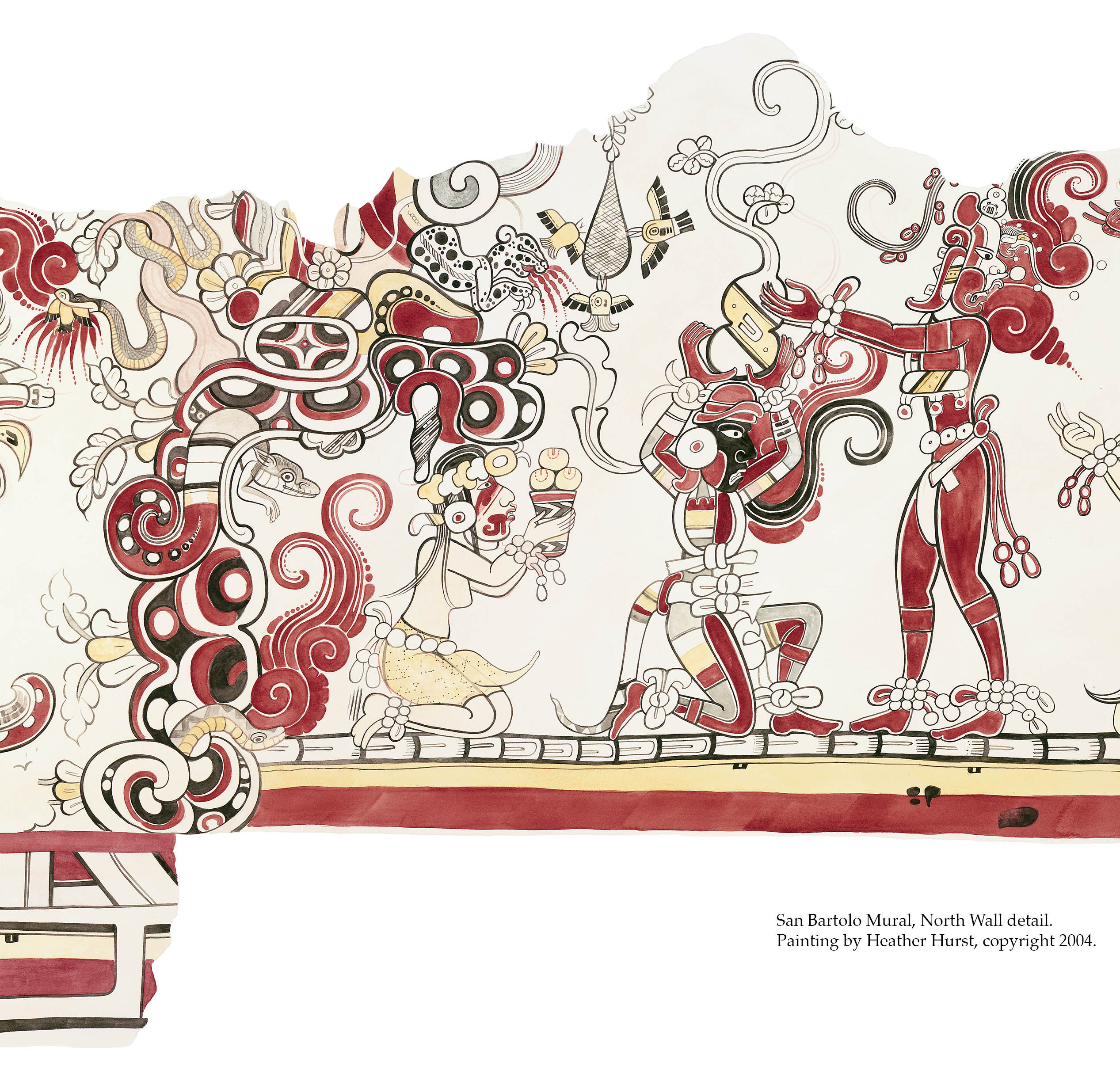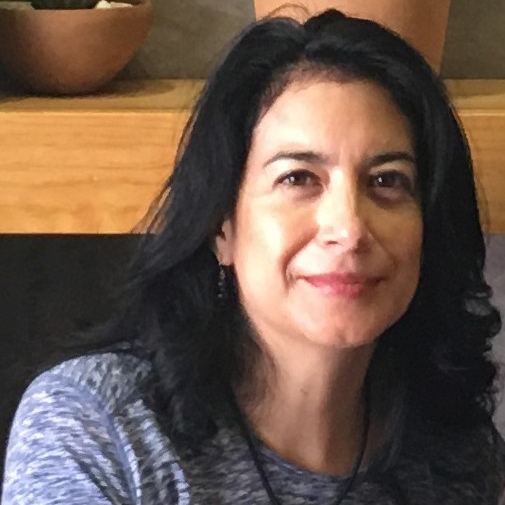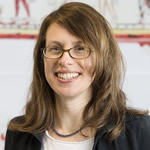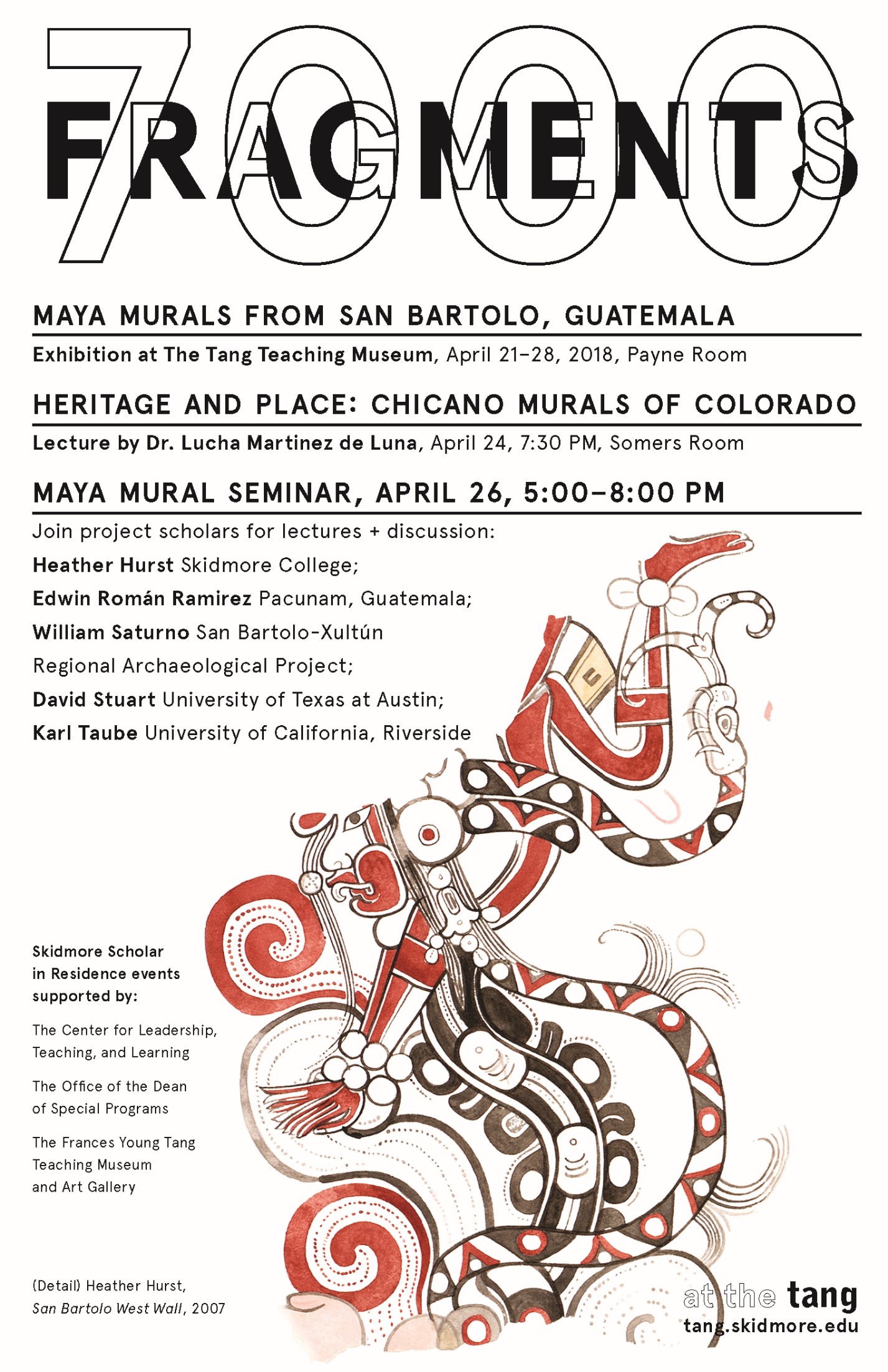CENTER FOR LEADERSHIP, TEACHING, AND LEARNING
AND THE Office of Special Programs
CO-SPONSORED SKIDMORE FACULTY RESIDENCy
7000 Fragments: Maya Murals from San Bartolo, Guatemala
Pop-up installation of artwork by Heather Hurst
April 21–28, 2018
The Tang Teaching Museum, Payne Room
At the culmination of 15 years of field work, laboratory analysis and art conservation, 7000 Fragments presents a life-size model of the mural chamber and new findings from the reassembled fragments.
Programming includes guest lecture, seminar, and brown bag events.
Heritage and Place: Chicano Murals of Colorado
Lecture by Lucha Martinez de Luna
April 24, 2018, 7:30 p.m.
The Tang Teaching Museum, Somers Room
The late 1960s marked a turbulent period in the United States, as disenfranchised, marginalized youth struggled to break the unrelenting cycle of inequality in the country. For the Chicano, a self-proclaimed term used to describe people of both Indigenous and Spanish descent from the American Southwest and Southern Colorado, this period marked a pivotal moment in history to publicly define their heritage and legitimize their place in the national landscape. Drawing inspiration from the Mexican mural movement and pre-Columbian cultures, Chicano artists painted murals throughout Colorado to inspire their community and celebrate their identity.

Lucha Martínez de Luna is an archaeologist specializing in Mesoamerica. She is director of the O'na Tök Archaeological Project in Chiapas, Mexico. She directs an archaeological field school and is a visiting professor of the University of Science and Arts in Chiapas. A Colorado native, she actively advocates for the preservation of Chicano public art and conducts research of the Hispano people and arts in the American Southwest and Colorado. She graduated from the University of Colorado at Denver and earned a master's degree from Brigham Young University.
7000 Fragments Gallery Talk with Heather Hurst
Wednesday, April 25, noon
Tang Teaching Museum, Payne Room
Maya Mural Seminar
Lectures and discussion
April 26, 2018, 5–8 p.m.
Tang Teaching Museum
7000 Fragments will host archaeologists for a Maya Mural Seminar. This event provides an extraordinary opportunity to experience the rich and complex imagery of the paintings and panelists will present new findings about the San Bartolo mural narrative. Panelists for the “Maya Mural Seminar” include Heather Hurst, Skidmore College; Edwin Román Ramirez, Pacunam, Guatemala; William Saturno, San Bartolo-Xultun Regional Archaeological Project; David Stuart, University of Texas at Austin; and Karl Taube, University of California, Riverside.
In 2001, ancient Maya murals were discovered at a previously unknown site in a remote tropical jungle of Guatemala. The San Bartolo murals (c. 100 BCE) are among the most important Maya artifacts ever found. The beauty and age of the ancient painting that emerged from beneath meters of rock and construction fill surprised scholars and rewrote what we know of Maya kings, artists and scribes. The murals visually narrate the creation of the world, depicting a painted landscape of zoomorphic serpents and anthropomorphic caves. However, the in situ murals buried within the pyramid are only part of the story: The site once contained many more paintings, but these artworks were intentionally broken into fragments and concealed by the Maya. At the culmination of 15 years of field work, laboratory analysis and art conservation, 7000 Fragments presents a life-size model of the mural chamber and new findings from the reassembled fragments.
7000 Fragments: Maya Murals from San Bartolo, Guatemala is organized by Associate Professor of Anthropology and Skidmore Scholar in Residence Heather Hurst and is supported by the Center for Leadership, Teaching, and Learning, the Office of Special Programs and the Tang Teaching Museum.
Re-Discovering the San Bartolo-Xultun Intersite Area: Personal Reflections on 1 K'atun
of Remote Sensing the Maya
Brown-bag lecture by Thomas G. Garrison
April 27, 2018, 2 p.m.
Tang Teaching Museum, Payne Room
Thomas G. Garrison is assistant professor of anthropology at Ithaca College. He previously taught at the University of Southern California and held postdoctoral fellowships at Brown University and Umeå Universitet, Sweden. He received his Ph.D. from Harvard University in 2007, writing his dissertation on the application of remote-sensing technologies to the settlement investigations at San Bartolo, Guatemala. He has collaborated with the Marshall Space and Flight Center, Jet Propulsion Lab and the National Center for Airborne Laser Mapping to develop applications of remote-sensing technologies in archaeology. Since 2012, he has served as director of the Proyecto Arqueológico El Zotz, following three years of regional investigations around the site. He is a co-author of Temple of the Night Sun: A Royal Tomb at El Diablo (2015) and co-editor of the forthcoming volume An Inconstant Landscape: The Maya Kingdom of El Zotz, Guatemala (2018). Since 2016, he has served as an advisor to the PACUNAM LiDAR Initiative, the largest remote-sensing and GIS project ever established in Mesoamerica.

Heather Hurst, associate professor and chair of the Department of Anthropology, is the first Skidmore Faculty Scholar-in-Residence, supported by the Office of Special Programs, the Center for Leadership, Teaching, and Learning, the Tang Teaching Museum and the Dean of the Faculty/Vice President for Academic Affairs office for spring 2018.
Hurst has spent the last 15 years working at the site of San Bartolo, Guatemala, investigating and illustrating the fragile wall paintings that are one of the single most important ancient Maya artifacts ever discovered. Her residency, titled "Maya Murals of San Bartolo," will use print, visual, digital and archival materials to engage our community in discussions about cultural heritage preservation, artists and political authority, origin mythology, bodies and artistic expression. A series of events will bring various scholars and artists to campus throughout the semester as she illustrates a new corpus of the epic creation story ancient artists expertly rendered two thousand years ago. This work will culminate in an exhibition at the Tang Teaching Museum, April 17–28, featuring a life-size reconstruction of the mural chamber. The result of Hurst’s faculty residency will be an exhibition opening in June 2018 with a bilingual museum catalog and teaching materials at the National Museum of Archaeology and Ethnology in Guatemala City, which will be the permanent home of the San Bartolo mural corpus.
Hurst’s interdisciplinary work facilitates dialogue between archaeologists, materials scientists, conservators and art historians and at the same time disseminates images that engage both academics and the public in the study of Maya culture. Her work has been published in National Geographic, Science, Antiquity, and the New York Times and exhibited at the Metropolitan Museum of Art, National Gallery of Art and Los Angeles County Museum of Art, among others. Hurst was awarded a MacArthur Fellowship in 2004 and is currently a Guggenheim Fellow.
